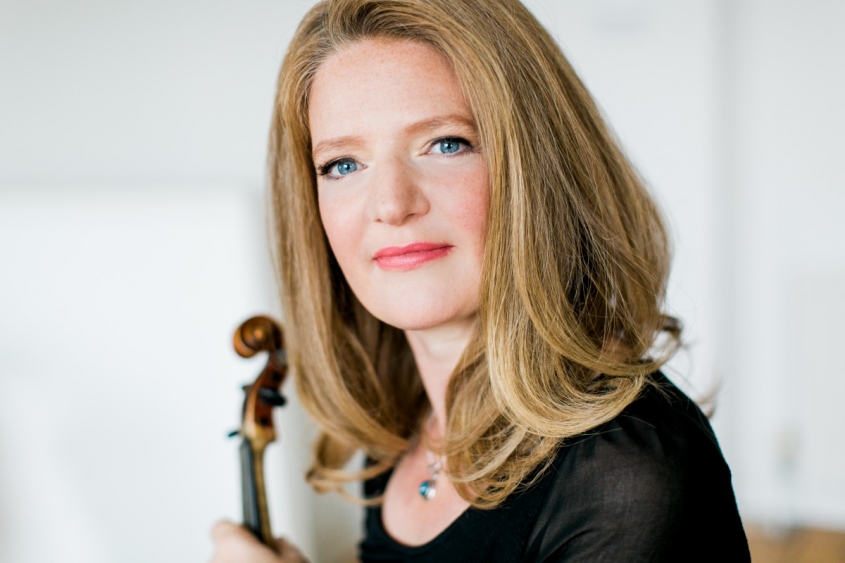Podger delivers stellar solo violin program at Library of Congress

Rachel Podger performed at the Library of Congress Tuesday night. Photo: Theresa Pewal
Rachel Podger made one of the best recordings of Bach’s solo violin works, over twenty years ago. Since then, the British violinist has been exploring ancillary repertoire for solo violin, including arrangements of Bach pieces for other solo instruments. She performed a selection from her new album, a survey of solo violin works by the generation of composers prior to Bach, at the Library of Congress Tuesday night.
Podger played most of the program on her 1739 Pesarinius violin, made in Genoa by Antonio Pezarini, a student of Stradivari’s. After finding the instrument in a London shop, she had its modern updating undone, to return it to its baroque state: a new neck and bridge, plus a shorter bass bar and fingerboard. As usual, she used a baroque-style bow on strings that are mostly gut, with only the lowest being a wound gut-composite string.
The sound of her playing proved just as delightful live as it is on her recording. Unlike her last visit to Washington, as soloist with the English Concert at the Library of Congress in 2010, there were no distractions from the clarity, warmth, and musicality of her sound. Few musicians could demand such complete attention in such a program dominated largely by obscurities and narrate it with such understated charm and intelligence.
Podger’s survey started with a few selections from John Walsh’s Select Preludes & Vollentarys, a collection of brief, vivid solo pieces that shows the state of the violin in the first decade of the 18th century, in London and elsewhere. The concert opened with a Prelude in A Major by Nicola Cosimi, a Roman violinist based in London. Podger assayed its series of different moods, going from double-stops to more lyrical passages, with exquisite intonation.
Other pieces from the Walsh collection highlighted different strengths of her playing. Corelli’s Prelude in D Major was a bright etude of flashy arpeggios, while Carlo Ambrogio Lonati’s Prelude in D Minor leaned more intense and melodic. Purcell’s Prelude in G Minor was as inventive as it was brief, animated at times by Podger’s addition of vibrato as an expressive device, which stood out in her mostly vibrato-free style.
The first substantial work on the program was Johann Joseph Vilsmayr’s Partita No. 6, the last of six suites for solo violin in his 1715 collection Artificiosus Concentus pro Camera. Vilsmayr, a violinist who studied with Heinrich Ignaz Franz Biber in Salzburg, achieved a polyphonic style by accompanying himself with a sort of bass line. Ten short movements all popped in different ways: the florid ornamentation of the Prelude or the jaunty double-stops of the Aria con Variazioni.
Podger did something sensational with the eighth movement, a sublimely introspective Aria that she rendered with luscious delicacy. Graciously receiving the audience’s preemptive applause, Podger then outdid herself in the ninth movement, a comic Gigue with an echo effect, which she playfully turned away from the audience to create, her long hair flying about her. A shorter Fantasia in C Minor, by Nicola Matteis the Younger, later provided a gorgeous, mournful contrast.
Johann Paul von Westhoff, a violinist at Dresden’s Hofkapelle, was one of the earliest composers of music for unaccompanied violin. His Suite in A Major, from 1683, featured incredible facility from Podger in the multi-string passages of the Prelude, as well as high-spirited double-stops in the Allemande. This set of five movements reveled in contrapuntal complexity, but the pensive Sarabande stood out for its soulful melancholy.
Harpsichordist Chad Kelly made a violin arrangement of Bach’s Toccata and Fugue in D Minor, originally for organ. Podger played the Toccata with expressive longing, eschewing ornaments on the first couple statements of its famous opening. The Fugue, taken with measured solemnity, was a stupendous tour de force.
Kelly also composed a new work called Phantasia, commissioned by Podger as a complement to this program of baroque solo violin music. In the first of two sections, Podger strung together many allusions to early violin pieces, with sections in running notes or bariolage figures, often given modern, dissonant twists. In the second, more striking section, Podger wove together ostinato patterns on her violin with the third line of her voice, singing on a wordless vowel. This quiet, atmospheric effect mesmerized with its chant-like simplicity.
For the last piece on the program, Podger returned to her transcription of Bach’s Partita for solo flute, recorded some years ago. She performed this demanding work on a different instrument, the 1654 “Brookings” Amati from the Library’s collection. This concert was the debut of this spectacular violin, recently retrofitted to its baroque state. She played the Partita a little more slowly and cautiously, feeling out the unfamiliar instrument.
In her hands, the Amati sounded glorious, from a golden high note that ended the Allemande to the poignant lushness of the Sarabande. Podger, seeming to hit her stride, added daring ornaments to the repeats of the Corrente and Bourrée Anglaise. Sticking with the Amati, Podger offered three short encores, dances notated in the Nogueira Manuscript, found in Portugal, just the right digestif after an extraordinary meal. Perhaps a new Podger recording of Bach’s solo sonatas and partitas, on this extraordinary violin, is in order.
Most of Washington is glued to the returns on election night, which was likely to blame for the relatively small audience in the sublime acoustic of Coolidge Auditorium. Although listeners are delighted at the return of the library’s free concert series, one of the city’s musical jewels, the switch to a new general seating system has been less popular.
The Smetana Trio plays music of Rachmaninoff, Martinů, and Smetana 8 p.m. Wednesday. loc.gov


